Ikram Ul Haq1, Khalid S. Al Fouzan2, Zameer Baladi3
1College of Dentistry, King Saud bin Abdulaziz University for Health Sciences, Riyadh, Saudi Arabia
2Academic and Student Affairs, College of Dentistry, King Saud bin Abdulaziz University for Health Sciences and Dental Services Department, Head Section of Endodontic Department, King Abdulaziz Medical City, Riyadh, Saudi Arabia
3College of Applied Medical Sciences, King Saud Bin Abdulaziz University for Health Sciences, Riyadh, Saudi Arabia
Correspondence to: Zameer Baladi, College of Applied Medical Sciences, King Saud Bin Abdulaziz University for Health Sciences, Riyadh, Saudi Arabia.
| Email: |  |
Copyright © 2017 Scientific & Academic Publishing. All Rights Reserved.
This work is licensed under the Creative Commons Attribution International License (CC BY).
http://creativecommons.org/licenses/by/4.0/

Abstract
Bibliometric studies have been carried out to assess the research productivity in the different field of knowledge. Kingdom of Saudi Arabia plays a leading role in the field of medical research in all Arab States. There are 64 universities and degree awarding institutions in KSA, King Saud bin Abdulaziz University for Health Sciences (KSAU-HS) established in 2005. The aim of this study to assess the oncology research outcome having an authorship affiliated with KSAU-HS, its teaching hospitals, and King Abdullah International Medical Research Centre (KAIMRC) published during the inception of the university to Dec 2015. Data retrieved from Institute of Scientific Information (ISI) web of science, InCiteTM Database of Thomson Reuters, which produced the list of 775 research documents published in 346 different journals, out of these 45 articles are written on the subject of oncology in 19 different journals. Majority of articles (91.11%) are written in collaborative efforts. In 33 (73.33%) publications, the principal author belongs to KSAU-HS, its associated hospital and research center. Almost half of the research papers (55.55%) are written in collaboration with researchers at other universities/hospitals and organizations. This study is only based on the bibliography produced by ISI’s Web of Science database. The articles produced by KSAU-HS may be more than this number. The data was analyzed by using MS-Excel 2010.
Keywords:
Oncology research, Research productivity, Bibliometric analysis, Saudi Arabia, InCitesTM Web of Science, Biomedical publications
Cite this paper: Ikram Ul Haq, Khalid S. Al Fouzan, Zameer Baladi, Oncology Research Outcome by King Saud bin Abdulaziz University for Health Sciences, Kingdom of Saudi Arabia; A Bibliometric Appraisal, International Journal of Library Science, Vol. 6 No. 3, 2017, pp. 52-57. doi: 10.5923/j.library.20170603.02.
1. Background
Kingdom of Saudi Arabia (KSA) is the largest country in the Arabian Peninsula and located in the southwest corner of Asia. The kingdom of Saudi Arabia (SA) has made remarkable advances in the health services. Saudi Arabia's educational system involves a large number of schools, colleges, and universities. Higher education has expanded rapidly, out of 64 universities in KSA 24 belong to the public sector. [3, 4] The rate of literacy is 97% among males and is about 91% among females. [1] KSA keep a leading position in the field of medical research in all Arab States. Cancer and related disorders are one of the most challenging medical problems globally and KSA is not exempted, as it found one of the main causes of mortality in the Kingdom. King Saud bin Abdulaziz University for Health Sciences (KSAU-HS) came into being 2005, being the first public sector specialized health care university not only in KSA but also in the Middle East Region. KSAU-HS and King Abdulaziz Medical City (KAMC) try hard toward evolving strong-grounded research culture and encouraging collaborative research activities. Department of oncology of KAMC has not been treating the ailing population of KSA but also conducting state of the art research in this field. Bibliometric studies have been conducted increasingly for research assessment. [6] Alan Prichard coins the term bibliometric in 1969, it is quantitative research method applied to physical published items. [7] Harrods’s Library Glossary and Reference Book describes bibliometric as “application of statistics and mathematics to the study of the use made of books and other media …”. [8]
2. Objective of the Study
Research publications of the faculty members of any institute constitute a crucial measure of the achievements frequently regarded as an index of Institute prestige. The aim of this paper is to evaluate the growth of publications on oncology produced by KSAU-HS / KAMC up to December 2015.
3. Materials and Methods
This is an observational study conducted at College of Dentistry, KSAU-HS, KSA from May to Oct 2016. The research documents produced by the researchers of the KSAU-HS / KAMC were browsed using bibliometric indicators from InCitesTM database Institute of Scientific Information (ISI’s) Web of Science. This database produces the list of 775 documents published in 346 different journals, having an authorship affiliation with KSAH-HS, its teaching hospitals and King Abdullah International Medical Research Centre (KAIMRC) published up to December 2015, out of these 775 articles, 45 articles are written on the subject of oncology in 19 different journals. The data were analyzed by using MS-Excel 2010.
4. Limitation and Future Research Direction
This study has some limitations, data used in this report was retrieved from ISI’s Web of Science database having authorship affiliation with KSAU-HS / KAMC. The future researchers may include the bibliographic citations from Google Scholar and SCI-mago/Scopus databases. This study is quantitative but it can be qualitative by using Impact factor scale of journals.
5. Results
Year wise distribution shows that there has been up and rise in the growth of publications. The first article on oncology was published in 2007, 2010 has been very productive year, 10 articles/documents (22.22%) published during this year. Table 1. Year Wise Distribution of Published Documents
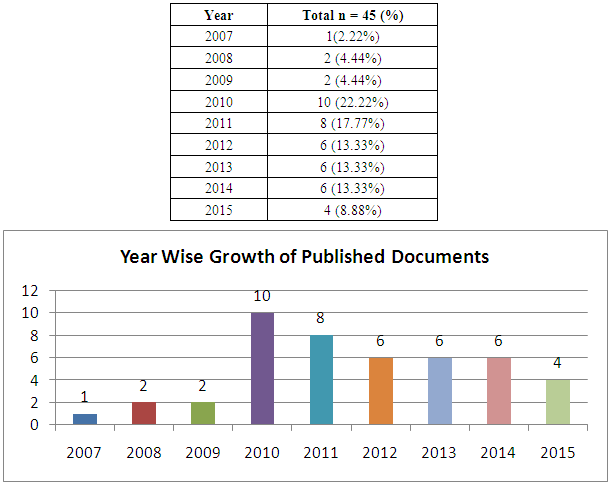 |
| |
|
These 45 articles/documents published in 19 different journals, 9 articles (21%) appeared in Journal of Clinical Oncology and the same number in Annals of Thoracic Medicine followed by Asian Pacific Journal of Cancer Prevention (13.33%), and Annals of Saudi Medicine (6.66%). There are 12 journals where only one article published by our researchers.Table 2. Journals with High Publication Percentage
 |
| |
|
Table 3 shows that 775 articles have been segregated in 48 main subjects, only 10 included here. The research on Oncology come on third, the majority of articles (15.35%) are written on the subject of Medicine, followed by Public Health (8.77%), Oncology (5.80%) and Gynecology (5.67%). Table 3. Subject Wise Distribution of Articles
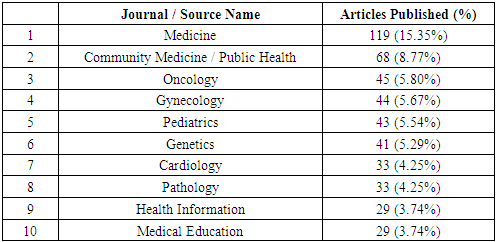 |
| |
|
Table 4 shows that 91.11% of the research has been carried out in collaboration, only 4 (8.88%%) research items have been written by single author, 3 (6.66%) articles are reported by two authors, three authors portion consisted of 5 (11.11%), and followed by four authors 6 (13.33%). Majority (57.77%) of the research has been produced by five or more than five authors.Table 4. Authorship pattern and percentage
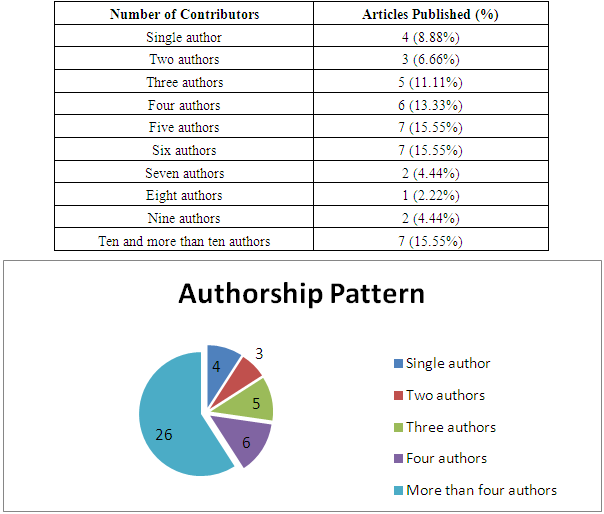 |
| |
|
It is interesting to state the result of principal author’s affiliation indicates that in 33 (73.33%) articles, the principal author belongs to KAMC / KSAU-HS, whereas researchers of other organizations counted only 26.66%. Table 5. Principal Author’s Ratio
 |
| |
|
Table 6 displays that in 20 (44.44%) articles, all the contributors and researchers belong to KAMC / KSAU-HS. Majority of the research papers (55.55%) have the contributors of other universities / hospitals and organizations.Table 6. All Contributors Belong to KAMC / KSAU-HS and Collaboration with other Organization Ratio
 |
| |
|
KAMC / KSAU-HS collaboration with other universities, hospitals and organizations There are 20 organizations in 6 countries, where KAMC / KSAU-HS researchers work together in producing research papers. Table 7 shows the university/organization wise ratio of research collaboration. Most of KAMC / KSAU-HS researchers contributed their research with the researchers of Riyadh Military Hospital (8.88%), followed by King Saud University (4.44%), and McGill University (4.44%). Details of other organization showed in the following table.Table 7. KSAU-HS collaboration with some major universities, hospitals and organizations
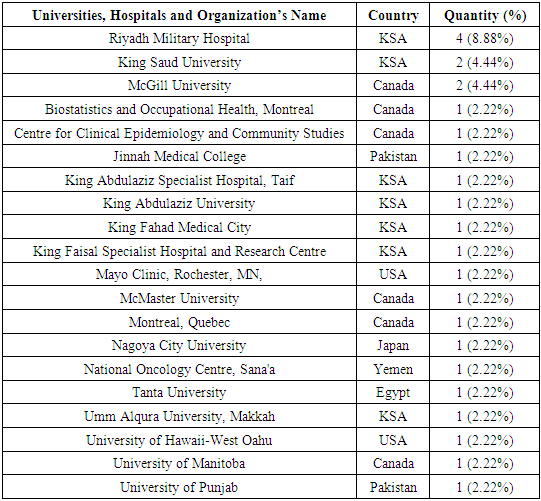 |
| |
|
KAMC / KSAU-HS collaboration with different countries and their universities KAMC / KSAU-HS researchers have collaborated with 20 universities, hospitals and organizations of 7 countries including KSA. Collaboration within KSA universities / hospitals (24.44%) followed by Canada (15.55%), United States (4.44%), Pakistan (4.44%), Yemen (2.22%), Egypt (2.22%) and Japan (2.22%). Table 8. KAMC / KSAU-HS collaboration with other universities of different countries
 |
| |
|
KAMC / KSAU-HS Most Productive AuthorsTwo hundred and sixty-seven authors contributed in 45 articles, out of this 133 belong to KSAU-HS / KAMC, per articles author ratio comes, 5.93. Abdul-Rahman Jazieh has been playing a leading role in research activities of KAMC by contributing in 20 articles tracked by Hani M. Tamim in 9 articles and Ashwaq Aman Mohammed Alolayan in 7 articles. Table 9. Most productive author
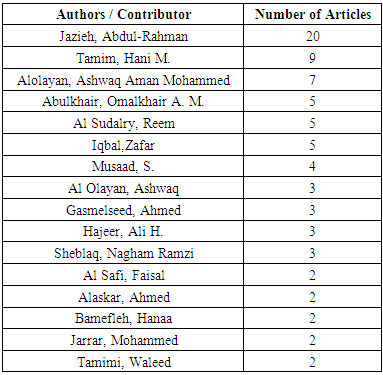 |
| |
|
Reference Ratio per ArticleOut of 45 research studies on oncology, 11 abstract are also included in this list. These abstracts have appeared in various journals without any reference. Other 34 articles contain 1236 references, the ratio of reference comes 36.35 per article. Most of the articles (9, 26.47%) comprise 21-30 references, there are only five articles which contain more the fifty references. Table 10. References per article
 |
| |
|
6. Discussion
In this study, publication productivity and collaboration in the subject of oncology by KSAU-HS / KAMC over the period of 2005-2015 had been analyzed. Data were retrieved from Web of Science, InCiteTM Database of Thomson Reuters Institute for Scientific Information (ISI). In Shehata and Mahmood’s study revealed that out of 65 KSA research producing organizations, KSAU-HS/KAMC stands on 23.9. Majority of articles (15.35%) are written on the subject of Medicine, followed by Public Health (8.77%), and Oncology (5.80%) in this report. Shehata and Mahmood described in his paper that 81.1% of total KSA research had been the result of collaborative efforts, whereas in our study, 41 (91.11%) publications are produced in collaboration. In 20 (44.44%) publications, all the contributors and researchers belonged to KSAU-HS / KAMC. There are 20 universities, hospitals, and organizations of 7 countries including KSA, where our researchers work together in producing research. Shehata and Mahmood revealed in a study that 88,506 papers produced by KSA during 1980-2014, out of this, 24,937 belongs to Clinical, Pre-Clinical and Health discipline. King Saud University created 27,302 (30.85%) papers, whereas the share of KSAU-HS / KAMC is 573 (0.65%). Research collaboration ratio with the USA is high (23.31%) followed by Egypt (22.95%), UK (9.54%) and Canada (7.42%). Paper suggested that there is dire need to develop national research policy to foster and support collaborations among researchers, universities, and countries. [9] Latif, R. carried out the study of medical research productivity affiliated to KSA during 2008-2012 based on peer-reviewed journals indexed in PubMed only. There was 1562 articles published in a targeted period, more than half (54.3%) of the citations created from Riyadh. She concluded that although there has been increased in research productivity in KSA but still need to enhance the research culture in the country. [11]Meo, SA et al. reported the research outcome of KSA in medical sciences during 1996-2012 based on ISI’s web of science and SCI-mago/Scopus databases. Results revealed that 27246 research papers published, major area of research is medicine (16196), followed by Biochemistry, genetics and molecular biology (5399) and dentistry (631). [4]Al-Bishri evaluated the biomedical research in KSA between 2010 and 2011 grounded on PubMed results. There were 1905 articles published during this period, the majority of articles (65.3%) originated from Riyadh and bulk of studies (15.5%) related to community medicine. He exposed that although KSA stands 16th in medical research with reference to population size but still lagging behind in comparison with other high-income countries in the field of medical research. [12] Tadmouri and Tadmouri discussed the biomedical research creativity in KSA during 1982-2000 through ISI’s web and science and PubMed database. Results showed that half of the research articles produced by two organizations, King Saud University (29.5%) and King Faisal Specialist Hospital (21.5%), both located in Riyadh. [13]
7. Conclusions
Saudi Arabia has been investing huge amount and doing progressive efforts to improve the quality of higher education and research output during last two decades. According to Scimagojr Journal and Country Rank, Kingdom of Saudi Arabia stood on 50th number in 2005, now its reaches on 33 positions in 2015.14 KSA is playing a leadership role and model for all Arab States in the field of medical research and productivity. High tech medical research has a direct impact on the general health and well-being of citizens. Research productivity in the university environment is an important gauge to evaluate the productivity of faculty members. KSAU-HS and its affiliated hospitals striving well to achieve excellence not only in medical research but also by delivering education and provision of the health care delivery system to the ailing community in befitting manners.
References
| [1] | “Saudi Arabia”. The World Factbook, Central Intelligence Agency [US]. Available at: https://www.cia.gov/library/publications/the-world-factbook/geos/sa.html [accessed on 2016, Nov 30]. |
| [2] | Kingdom of Saudi Arabia, General Authority of Statistics. Population Estimates. Available at: http://www.stats.gov.sa/sites/default/files/estm_pop_2016_4.pdf [update 2016, Jul]. |
| [3] | Kingdom of Saudi Arabia, Ministry of Higher Education, “Development and Modern Revival”. Available at http://mohe.gov.sa/en/studyinside/aboutKSA/Pages/development-and-renaissance.aspx [updated on 2015, Mar 24]. |
| [4] | Meo SA, Hassan A, Usmani AM. Research progress and Prospects of Saudi Arabia in global medical sciences. Eur Rev Med Pharmacol Sci 2013; 17: 3265-3271. |
| [5] | Al-Ohali M, Shin JC. Knowledge-based innovation and research productivity in Saudi Arabia. In: Smith L, Abouammoh, A, eds. Higher Education in Saudi Arabia: Achievements, Challenges and Opportunities; Higher Education Dynamics 40. Springer Link, New York 2013; 95-102. |
| [6] | Bissar-Tadmouri N, Tadmouri GO. Bibliometric analysis of biomedical research outputs in Lebanon and the United Arab Emirates (1988-2007). Saudi Med J 2009; 30(1): 130-139. |
| [7] | Hertzel, DH. Bibliometric History. In: Drake M, eds. Encyclopedia of library and information science, 2nd ed. CRC Press, New York 2013; 288. |
| [8] | Prytherch R. Harrod’s librarians’ glossary and reference book: a dictionary of over 10,200 terms, organizations, projects and acronyms in the areas of information management, library science, publishing and archive management 10th ed. Ashgate, Hampshire 2005; 67. |
| [9] | Shehatta I, Mahmood K. Research Collaboration in Saudi Arabia 1980-2014: Bibliometric Patterns and National Health Policy to Foster Research Quantity and Quality. Libri 2016; 66(1): 13-29. Available at DOI:10.1515/libri-2015-0095. |
| [10] | Dikak HA, Kiadbey H, Sabra R. Research productivity of the medical faculty at the American University of Beirut. Postgrad Med J 2006; 82(969): 462-464. Available at DOI: 10.1136/pgmj.2005.042713. |
| [11] | Latif R. Medical and biomedical research productivity from the Kingdom of Saudi Arabia (2008-2012). J Fam Community Med 2015; 22: 25-30. Available at http://www.jfcmonline.com/temp/JFamCommunityMed22125-160668_042746.pdf. |
| [12] | Al-Bishri J. Evaluation of biomedical research in Saudi Arabia. Saudi Med J 2013; 34(9): 954-959. Available at http://www.smj.org.sa/index.php/smj/ article/view/1874/705. |
| [13] | Tadmouri GO, Tadmouri NB. Biomedical research in the Kingdom of Saudi Arabia (1982-2000). Saudi Med J 2002; 23(1): 20-24. Available at http://www.smj.org.sa/index.php/smj/article/view/3950/1724 |
| [14] | “SJR – International Science Rankings – Scimago journal and country rank.” Available at http://www.scimagojr.com/countryrank.php [assessed on 2016 Oct 30]. |



 Abstract
Abstract Reference
Reference Full-Text PDF
Full-Text PDF Full-text HTML
Full-text HTML








